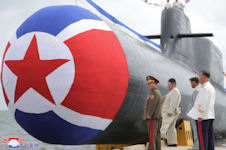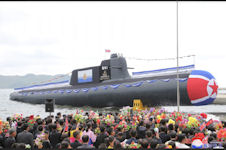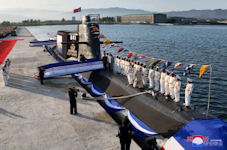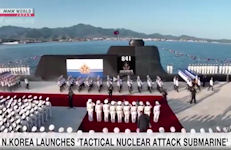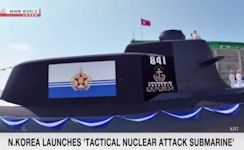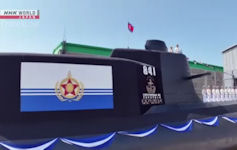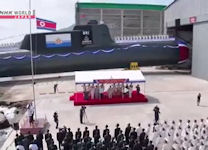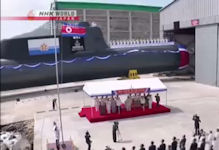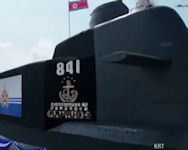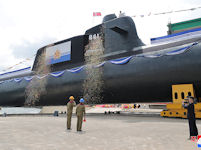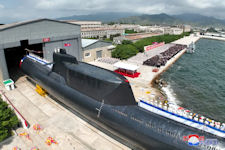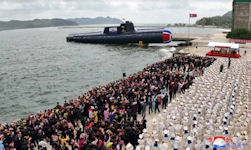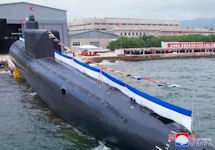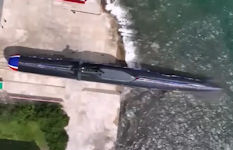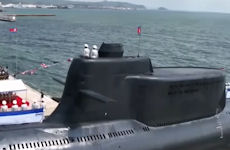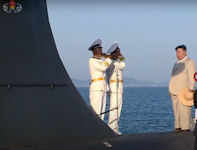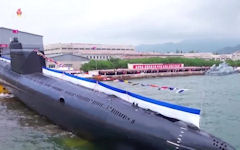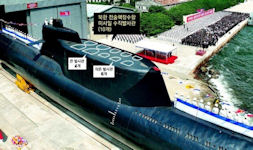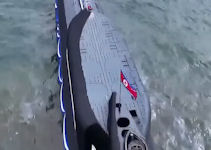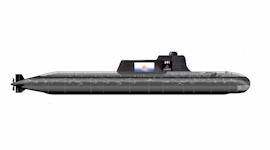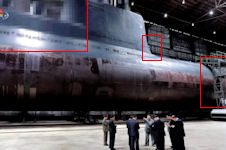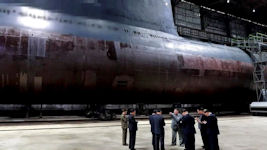"You're gonna need a bigger boat"
ROMEO-mod SSB NEWCON
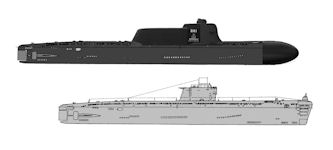 GlobalSecurity.org initially mis-identified this submarine as being a modification of the Gorae class. With the release of the full text of Comrade Kim Jong Un's speech at the ceremony for launching newly-built submarine, and the video thereof, it quite evident that the boatis a modification of a ROMEO submarine initially acquired from China, and subsequently produced in North Korea. While the bow of the SSB resembles that of the Gorae, the stern is clearly that of the ROMEO. And there are several passages in Comrade Kim Jong Un' speech that almost certainly reference the ROMEO. In this interpretation we sit at the feet of the master, HISutton.
GlobalSecurity.org initially mis-identified this submarine as being a modification of the Gorae class. With the release of the full text of Comrade Kim Jong Un's speech at the ceremony for launching newly-built submarine, and the video thereof, it quite evident that the boatis a modification of a ROMEO submarine initially acquired from China, and subsequently produced in North Korea. While the bow of the SSB resembles that of the Gorae, the stern is clearly that of the ROMEO. And there are several passages in Comrade Kim Jong Un' speech that almost certainly reference the ROMEO. In this interpretation we sit at the feet of the master, HISutton.
North Korea launched a new submarine 07 September 2023 in a ceremony was attended by the country's leader Kim Jong-un, according to the North Korean Central News Agency (KCNA). "The ceremony of launching the submarine marked the beginning of a new chapter in strengthening the naval forces of the DPRK," the agency quoted the content of the message.
The KCNA news agency previously reported that the DPRK conducted an exercise with an imitation of a tactical nuclear strike on September 2 in response to joint maneuvers by the United States and South Korea . According to the KCNA, two long-range strategic cruise missiles with warheads simulating nuclear warheads were launched. The agency reported that they flew along an 8-shaped trajectory of 1.5 thousand kilometers in 7672 and 7681 seconds, after which they exploded at a given height of 150 meters above the “target island”.
According to the North's state media, the launching ceremony for Submarine Number 841, named "Hero Kim Kun-ok" after a North Korean war hero during the Korean War, was held at Sinpo shipyard in South Hamgyong Province.
The Gorae-class submarine, had not seen extensive trialling, leading analysts to conclude the modifications were a failure. Still, while only able to launch one missile of much shorter range, this earlier sub served as a testbed for ideas that have come to fruition in this latest Sinpo-C design.
The submarine features the distinctive hump aft of the sail characteristic of Soviet-era ballistic missile submarines [most notably, the Delta IV]. At first glance, it appeared rather smaller than the boat previously seen under construction, but subsequently released photographs clarified the scale of the boat. Indeed, the new boat appears to be rather longer than the baseline Gorae. Presumably the DPRK resorted to the standard expedient of cutting the pre-existing design in half, and inserting a plug containing the missile tubes.
The Gorae SSK was estimated to be 67 meters long, 6.6 meters wide and has a dived displacement in the 3,000 ton range. The SSB is likely to be closer to 100 meters long, with a displacement probably in excess of 4,000 tons.
In July 2019, Kim had inspected a submarine that was being constructed. Pyongyang said the vessel would ultimately conduct operations in the Sea of Japan. South Korean forces have said that it can carry three submarine-launched ballistic missiles, or SLBMs. The submarine launched on 06 September 2023 could be the one Kim inspected in 2019.
Korean Central News Agency said the vessel – named “Hero Kim Kun Ok” [Kim Keun-ok] – is designed to launch tactical nuclear weapons from underwater but did not specify the number of missiles it could carry and fire. The KCNA report identifies Kim Kun Ok as "the hero commanding officer of the first generation of the naval force of the Republic". Russian sources report the submarine is named after a North Korean historical figure who supposedly managed to sink the USS Baltimore in 1950 during the conflict between North and South.
The Victorious War Museum, or the Victorious Fatherland Liberation War Museum, is a museum in Pyongyang, North Korea. The Victorious Fatherland Liberation War Museum is the DPRK’s most lavish museum. The museum is dedicated to the Korean War and North Korea's belief that it won the war. This alternative reality depicts how the evil USA started the Korean War and was totally defeated by the valiant Korean people. The major role played by China is no where to be seen.
The museum displays a large collection of captured US military artifacts and artillery pieces, including the USS Pueblo. It also has vivid illustrations, weapons used during the Korean Civil War, and scene reconstructions. The museum was originally built in 1953, but was moved to its current location in 1963. It underwent major renovations in 2013. It was visited by 800,000 people in 2013 alone. Visitors who would have really liked to have taken pictures from within the museum are able to purchase a photo book of the museum of every room.
North Korea advertises this facility as “an excellent school that equips workers, young students, and People’s Army soldiers with the great leader Comrade Kim Il-sung’s immortal Juche ideology and anti-imperialist revolutionary ideology, excellent military skills, and military strategy and tactics.”
The outside of the museum is full of distorted and propagandistic monuments, and the interior is full of distortion and propaganda, such as the Korean invasion of North Korea /false documents/propaganda materials claiming that the war ended in North Korea's victory. For example, it contains stories that are impossible to common sense, such as the fact that North Korea shot down 12,700 US military aircraft throughout the war. The museum is permanently closed.
The Victorious War Museum claims that the Korean People's Navy sank the USS Baltimore on July 2, 1950. The museum has exhibits that include a poster and the boat that supposedly sank the American cruiser. The museum claims that four torpedo boats attacked and sank the cruiser. One of the boats is preserved in the museum. The North Korean naval leader who led the operation that supposedly sank the USS Baltimore was named Hero Kim Kun Ok. The submarine was named after him.
On 2 July 1950, light cruiser Juneau (CL-119) and two Allied ships sank three of four North Korean PT-boats and two of two motor gunboats in the Battle of Chumonchin Chan. This was the first and last surface engagement between the U.S. and North Korean navies, as it convinced the North Koreans to never try that again (at least until the Pueblo—AGER-2—incident in 1968).
The USS Baltimore (CA-68) was the lead ship of the largest class of heavy cruisers ever built. She was the fifth U.S. warship to bear the name Baltimore. The USS Baltimore was launched on July 28, 1942. After World War II, the USS Baltimore was briefly mothballed, but was recommissioned for the Korean War. She was decommissioned in 1956 and sold for scrapping in May 1972.
Kim insisted that the submarine would be just as “daunting” to his enemies as the nuclear-propelled submarine North Korea plans to acquire in the future. “In submarines, technical aspects such as the power system, submergence speed, and the level of navigational equipment are all very important and would generally define (the vessels’) operational capabilities, but nothing is more important than the type of weaponry that could be installed,” he said.
North Korea’s version of the Romeo-class submarines, capable of carrying its submarine-launched ballistic missile (SLBM) Pukkuksong-1, is the diesel-electric Sinpo. The submarine has a range of 2,800 kilometers (1,740 miles). It is therefore widely seen as yet to acquire the ability to launch blue-sea operations. Even when factoring the Pukkuksong-1’s operational range, it could be widely seen to fall short of posing a direct threat to the U.S. mainland, which is around 10,000 km from North Korea’s eastern coast.
A modified Russian design, it uses a diesel engine that can in turn charge a series of batteries, allowing the submarine to run virtually silent when needed. Diesel-electric propulsion is a decades-old technology, but North Korea has radically altered the design, stretching the sail to include some missile launch tubes.
Still, submarine-launched ballistic missiles present a challenge to the U.S. and its allies’ defense system due to their inherent stealth and unpredictability. Operating underwater complicates the existing radar detection system and makes it difficult to track North Korea’s military movements, disabling a preemptive strike.
Long-range missiles launched from land would be quickly spotted and tracked as anti-missile batteries were alerted. However, this new submarine would, in theory, be able to travel underwater, closing in stealthily on its target. The closer the sub could get, the less distance is needed for the missile to travel to its target, giving very little time for the target to react and defend itself.
This submarine gives North Korea a region-wide offensive capability it did not possess before and is designed to take the fight to potential adversaries in the Pacific, such as Japan or United States’ bases as far away as Guam.
The missile itself is solid-fueled and has a range of 1,900km. Also, the angle from which submarine-launched ballistic missiles (SLBMs) are launched could be an issue for anti-ballistic missile systems, like the Terminal High Altitude Area Defense system (THAAD). THAAD is designed to intercept and destroy ballistic missiles during their final phase of flight and was deployed to South Korea in 2017. The launch angle, time in the air and distance to target all make the Pukguksong-3 a powerful addition to the country’s arsenal, able to deliver a nuclear warhead anywhere within range, with little to no warning.
Seoul's Joint Chiefs of Staff said that the vessel appears to be a modified Soviet-era Romeo-class submarine, which North Korea imported from China in the 1970s and started to produce domestically and assessed that it's not capable of normal operation and that there's a possibility of exaggeration by the North. It also said that it will closely cooperate with Washington to maintain military readiness as the two nations were planning to hold high-level talks on extended deterrence next week in Seoul to better counter the North's threats.
An official from South Korea's Joint Chiefs of Staff (JCS) said although the North appears to have enlarged parts of the submarine's exterior, including the bridge for missile loading, it is not deemed ready for operational use. He added that it is likely the regime only unveiled the parts that do function normally. When asked by reporters whether the latest submarine is a newly built model, the official said there is a high chance that the North modified an existing model, speculating that it could be an improved version of the Romeo-class submarine unveiled in 2019.
“The ROK military has been using joint surveillance assets to track North Korea’s submarine activities in advance in coordination with the U.S.,” South Korea’s Joint Chief of Staff said in a statement. “Based on our analysis of the North Korean submarine's appearance to date, we believe that it appears to have increased the size and shape of some parts, such as the bridge, to accommodate missiles, but it does not appear to be operational,” the statement added, raising the possibility that North Korea may have exaggerated its capability.
“The modified submarines put South Korea and Japan under its range, and in theory, Guam as well,” said Cha Du-hyeogn, South Korea’s former presidential secretary for crisis information who is now a research fellow at the Asan Institute for Policy Studies. “However, questions remain regarding its actual capabilities. It is still unconfirmed whether the submarine can withstand a missile strike, move silently underwater, or effectively launch an SLBM from beneath the surface.”
“If conflict were imminent on the Korean Peninsula, you wouldn’t want to be a crew member on that submarine. Even if its nuclear attack capability is largely a bluff, that loud, slow boat could be sunk as soon as it left port,” Leif-Eric Easley, a professor at Ewha University in Seoul, told Al Jazeera. “It’s another example of North Korea misallocating resources against the welfare of its people. Kim wants to increase military power, but when Pyongyang is more threatening, it is actually less secure. ”
The ROK Unification Ministry also deplored how the North wastes its resources by developing weapons while ignoring the difficulties of public welfare. "North Korea should realize that their provocations are meaningless as Seoul, Washington, and Tokyo strengthen military readiness and this is only going to make them vulnerable in security."
One South Korean expert said the launch was to cover up their failure in economic measures. "The only thing that's currently working out well is the military development sector. So, it's externally and internally showing off that its weapon production is proceeding smoothly, despite global pressure and sanctions."
Kim called for accelerating a project to deploy underwater and surface vessels equipped with tactical nuclear weapons to the regime's naval forces. He also announced plans to modify additional medium-sized submarines to attack submarines equipped with tactical nuclear weapons, and to even develop a nuclear-powered submarine.
Kim reportedly said in a speech that the submarine is capable of carrying a large amount of nuclear arms and launching preemptive and retaliatory attacks. He also said it "will perform its combat mission as one of core underwater offensive means of the naval force" of North Korea. Kim also expressed his intention to accelerate development of the country's first nuclear-powered submarine. In 2021, the country pledged in its five-year national defense program that it would develop such a vessel. Although North Korea has expressed some will for that part, it needs help from Russia or China because its own technology or parts procurement are clear in this area, and Russia is also very cautious in this area these days.
Kim Jong Eun, The Supreme Leader Of Korea, looked over the newly constructed submarine "No. 841 Hero Kim Kun Ok, which is to be launched today, is the standard type of tactical nuclear submarine, after which we intend to convert the existing medium-sized submarines of our Navy into an attack type, as I mentioned on the last Navy Day. Our intention to turn all the other existing medium-sized submarines into attack ones like this one, which can carry tactical nukes to play a significant role in modern warfare, in addition to our development-oriented, prospective plan for building nuclear submarines, is a “low-cost, hi-tech strategy” as part of the line of strengthening the naval forces adopted at the Eighth Congress of our Party.
"We intend to improve and maximize the weapons systems and underwater operation capabilities of the existing submarines like this one, so that they could take a great share in the long-term building up of the national naval forces. This will be a revolutionary step for ensuring maximum efficiency in the light of the defence and economic strategy and a revolutionary strategy for the development of the naval forces.
"Designed fully to meet the demands of the strategy of our Navy, the strategy of national defence and military strategy of war plan, this submarine constitutes a menacing means as it is capable of carrying a large number of means for delivering nukes of various powers and of launching a preemptive or retaliatory strike at the hostile states in any waters....
"In the past we, in developing the submarine industry, focused on building many small and fast submarines, true to our Navy’s mission which is restricted to defending our territorial waters in any case, as we believed we could use them to defeat the enemy at a stroke once they invaded us. But the times have changed beyond recognition, and the weaponry and operational aspects of the Navy and our will have changed as well.
"In a submarine, power system, underwater cruising speed and level of navigation equipment are very important–these are called operational capabilities in general–but it is my view that what type of weapons it is equipped with is most important and that when equipped with nuclear weapons, it is precisely a nuclear submarine....
"The means of nuclear attack submarine, which had been regarded as a symbol of aggression against our Republic over the past decades, has now become symbolic of our overwhelming might that can strike terror in the hearts of the shameless enemy, and the fact that it is a new attack submarine of our own style, which the world has never known, is a great auspicious event for all our people....
"... we must rapidly promote the work of converting all medium-sized submarines into attack ones, and thus nuclearize the existing submarines at one go in the true sense of the word."
The whole arrangement of masts and scopes must be properly studied and if possible streamlined so the drag can be minimised. This has been implemented in the new design, which features a streamlined housing atop the sail encasing masts.
Some appendages are necessary for control and cannot be eliminated. These are the forward hydroplanes needed for accurate depth keeping when slow and shallow at periscope depth. Fin mounting creates less water and hydraulic noise near the bow sonar but not such good control. Their internal operation requires the fin to be larger. A disadvantage for the fully moving sail-mounted forward fins in the new SSB design comes from the loading on the shaft and bearings that have to operate when under full hydrodynamic bending loads.
Resistance from sails (American usage) or fin (British/Commonwealth usage, otherwise known as its conning tower or fairwater), masts, snorkels and appendages need careful streamlining and attention in design. The major appendage is the fin (sail, conning tower, bridge, fairwater), which is a large contributor to the overall drag. Sail geometries are optimized for their hydrodynamic performance to minimize flow-induced noise, vibrations and wake effects by using faired leading and trailing edges. A large sail may contribute up to 30% of total resistance and a fully appended hull may have between 20% to even 60% more resistance than a bare hull. Sails on US submarines tend to be like streamlined stub wings, while many Russian designs favor longer squatter shapes.
A horseshoe vortex is formed about the base of the sail. The stagnation line is formed by the flow dividing either side of the sail. The horseshoe vortex generated around the appendage–body junction of submarines strongly influences the non-uniformity of submarine wakes. For a submarine, with a horseshoe vortex generated at the junction of the main body and the appendages, the submarine wake is dominated by a kind of highly non-uniform flow field, which has an adverse effect on the performance of the submarine propeller.The hydrodynamic noise from the horseshoe vortex can greatly destroy the acoustic stealth of underwater vehicles at low frequency.
Applying a fillet or cuff (alternatively called a cusped fillet, cusp, cusped sail fairing, etc.) at the sail-deck junction area and proper shaping of the sail tip can lead to a reduction of the resistance of several percent and a significant improvement of the propeller wake field. It was observed that the fillet effectively weakened the vorticity in the horse shoe vortex. The American SSN-21 USS Seawolf is considered the most advanced and lethal submarine ever created, and incorporates such a cuff fillet. The new ones are fiberglass, but the fillets on the Seawolf and early Virginias are steel. While the new North Korean SSB incorporates a cusped sail fairing, it is probably steel. suggested by the bottle of champagne that was smashed against it as part of the christenting.
With supreme leader Kim Jong Un looking on, the foreign minister smashed a bottle of champagne against the hull of North Korea’s latest nuclear submarine, prompting the crowd of sailors and factory workers to erupt in thunderous cheers and applause. But the reaction to the smashed bottle among the general public was less than smashing. Many North Koreans saw the ceremony, involving Foreign Minister Choe Son Hui, as puzzling and even hypocritical in a country that suppresses superstitious activities – which is how the submarine christening appeared to many.
The authorities had been cracking down on the simple rituals of fishermen performing ancestral rites and pouring alcohol to ensure the safe navigation of boats, defining them as superstitious practices. North Korean fishermen have traditional ceremonies whenever they take a new boat out to sea or when they repair an old boat, and sometimes they involve elements of superstition that have been passed down over generations. Those rituals, which can involve a pig’s head and copious amounts of alcohol, are, like the submarine christening, meant only to wish for the safety of ships at sea.
The 2020 Anti-Reactionary Thought and Culture Act, is aimed at preserving the purity of North Korean socialist ideals by harshly punishing people for watching foreign media, speaking like a “South Korean,” wearing “capitalist” fashion, or even dancing like a “capitalist.” The law does not specifically mention superstitions and the fishermen are emulating their own ancestors rather than “capitalist” fishermen in the South, but authorities have interpreted their activity as “reactionary ideology” brought in from the outside.
The small ceremonies fall under Article 256, a different law that forbids fortune telling, divination, and exorcism as superstitious acts. According to that law, punishments can range from “up to a year” in a disciplinary labor facility to “a minimum of three to seven years” depending on how serious the act is. It was the first time that a ship christening was reported in state media.
Flood openings and limber holes in the hull represent a measurable and unwanted source of noise and drag. Teh new SSB etians this fetur eothe ROMEO design.
The shape of the nose is most important, as it is associated with the positioning of acoustic sensors and torpedo tubes as well as the starting conditions for the flow around the hull. Submarine bow shapes are typically optimised for deeply submerged sailing conditions. When sailing at the surface, this bow shape results in a significant wave making resistance. The new SSB appartently incorporates the blunt bulbous bow typical of American submarines.
If a laminar boundary layer is formed on a blunt nosed submarine shape then a separation bubble may exist. Transition over the bubble can be followed by turbulent reattachment, which is rather noisy [A laminar boundary layer creates a gentle hiss; a turbulent boundary layer creates a roar. However the boundary layer noise is confined and does not spread to the far field.] American submarines, almost entirely, have ellipsoidal nose shapes with the large passive sonar placed in the nose and torpedo tubes some way aft angling outwards from the surface.
The problem of noise, so critical for a submarine, can be alleviated by a more complicated, heavier and much more expensive arrangement, a shrouded propeller. But the propulsion end of the new SSB was seeminly intentionalloy blurred bby the DPRK, leaving this issue an open question.
Torpedo tubes were situated in the fore end of the submarine with a complicated system of tanks used to fire the torpedoes and compensate the weight of these with sea water. Wire-guided torpedoes require that the doors of the torpedo tubes remain open until the wire runs out or the decision is taken to cut it. Since this wire can be over 10 miles long, the submarine may be manoeuvring for a long while with open doors near the bow area which cause a certain amount of turbulent noise. There is also a risk that the wire may rub over the bow sonar casing thus causing more interference. The traditional location of the torpedo tubes in the vicinity of the bow is undesirable and, furthermore, with the widespread use of guided weapons that do not need to be aimed, unnecessary. The new SSB probably has elimnated the bow torpedo tubes featred on the ROMEO.
Long-range low-frequency sonars are housed in flank arrays. Long-range low-frequency sonars are housed in flank arrays. These arrays function best when mounted on constant-diameter sections of the hull, separated as far as possible along the length of the submarine and when recessed into a smooth hull so that flow turbulence is kept to a minimum. However, such arrays are ot in evidence on the new SSB.
For submarine missions that take place in littoral or shallow waters, the risk of detection is greater. A submerged submarine can leave a wake that is detectable from the air. The size of this wake increases with greater displacement and speed and less depth. The probability of detection by active sonars and magnetic anomaly detection equipment also increases with greater displacement and less depth. In addition, a submerged submarines' ultimate limitation in navigating shallow waters is its total submerged draught. Among the possible solutions to this dilemma, there should be a requirement for submarines to be smaller and stealthier while not losing any of their blue-water" capabilities.
DPRK leaders pursued a status of nuclear power for decades, considering this weaponry an insurance against Western meddling. In 2006, Pyongyang said it successfully tested its first nuke and in fall 2022 it adopted a comprehensive nuclear use law, indicating the situations and circumstances when this weapon may be unleashed. North Korea stressed that it is a “responsible nuclear-weapons state” which adheres non-proliferation rule and pledges not to share or transfer nukes or nuclear technologies to third countries.
Its nuclear forces have a wide range of objectives, starting from “defending the sovereignty, territorial integrity, and fundamental interests of the state” to “preventing a war on the Korean Peninsula and in Northeast Asia” while “ensuring the strategic stability of the world." Yet up to this moment, North Korean nuclear forces were mainly ground-based and the launch of new "tactical nuclear attack submarine" implies the "beginning of a new chapter" for its fleet, as the state-run news agency said.
 South Korea's intelligence agency said 06 May 2020 it had detected activity related to submarine-launched ballistic missiles, or SLBMs at a North Korean shipyard. The agency reported its findings to a parliamentary committee that met behind closed doors. According to the report, the agency spotted the activity at a shipyard in the eastern city of Sinpo. It involved equipment used in underwater launch tests and a new type of submarine that can carry SLBMs.
South Korea's intelligence agency said 06 May 2020 it had detected activity related to submarine-launched ballistic missiles, or SLBMs at a North Korean shipyard. The agency reported its findings to a parliamentary committee that met behind closed doors. According to the report, the agency spotted the activity at a shipyard in the eastern city of Sinpo. It involved equipment used in underwater launch tests and a new type of submarine that can carry SLBMs.
 North Korea's state media reported in July 2019 that leader Kim Jong Un had inspected a newly-built submarine that would be deployed in the Sea of Japan. Assessing images of the submarine at the time, the South Korean military had said it seemed capable of carrying three SLBMs. In October 2019, North Korea test-fired a Pukguksong-3 SLBM from waters near the eastern city of Wonsan. South Korean newspapers on 07 May 2020 said the new report suggests North Korea is preparing for another underwater test-fire or a submarine launch.
North Korea's state media reported in July 2019 that leader Kim Jong Un had inspected a newly-built submarine that would be deployed in the Sea of Japan. Assessing images of the submarine at the time, the South Korean military had said it seemed capable of carrying three SLBMs. In October 2019, North Korea test-fired a Pukguksong-3 SLBM from waters near the eastern city of Wonsan. South Korean newspapers on 07 May 2020 said the new report suggests North Korea is preparing for another underwater test-fire or a submarine launch.
North Korean leader Kim Jong Un inspected a large newly built submarine, state news agency KCNA reported 23 July 2019. There were two KCNA reports, "Kim Jong Eun, The Supreme Leader Of Korea, Looked Over The Newly Constructed Submarine" and "Kim Jong Eun Took A Look At His Newly Built Submarine". In the first of these articles, it was reported that "The Dear Leader of the Supreme Leader visited the newly built submarine and detailed the operational tactical specifications of the ship and the weapon combat systems. The Dear Leader of the Supreme Leader expressed great satisfaction about the design and construction of the submarine so that it can smoothly carry out the military strategic prayers of our party even in the context of each situation." The second article was nearly the same as the first, and added no details.
Kim "emphasized the need to steadily and reliably increase national defense capability by investing heavily in the development of naval weapons and equipment such as submarines," the KCNA reported. "The Supreme Leader has been informed of all the details of the operational and regular data (of the submarine) and its weapons system," the agency added. KCNA also released three photographs of the site visit, one of which provided a glimpse of the submarine itself. The closeup photo of the Supreme Leader suggests that the old boy is fit as a fiddle.
Some foreign observers suggested that the submarine is a Shinpo-C class ballistic missile submarine which appears to be being built [or in maintenance] at the North's Shimpo shipyard. Such an SLBM-equipped submarine could be used for two or three missile launch tubes. Analysts said the apparent size of the new submarine indicated that it was designed to eventually carry missiles. "We can clearly see that it is a massive submarine — much larger than the existing one that's been well known since 2014," Ankit Panda, senior fellow at the U.S.-based Federation of American Scientists, told Reuters news agency.
 The photograph of the submarine released by KCNA is not ideal for analysis of the boat's dimensions, as there is considerable fore-shortening of the boat's hull. Kim Jong Un is reported to be about 1.7 meters tall, though at times he wears special shoes that make him look taller. Using the Supreme Leader for scale, it appears that the height of the submarine hull, from keel to deck, is about 4 meters, more or less, which is presumably also the ship's beam. This is rather less than the estimated 7.7 meter beam of the Sinpo / GORAE submarine that was first detected in 2014, possibly due to the imprecision of this photographic analysis. It is vastly less than the 10 meter diameter attributed to the anticipated new Sinpo-C submarine, a discrepancy too great to write off as imprecise imagery mensuration.
The photograph of the submarine released by KCNA is not ideal for analysis of the boat's dimensions, as there is considerable fore-shortening of the boat's hull. Kim Jong Un is reported to be about 1.7 meters tall, though at times he wears special shoes that make him look taller. Using the Supreme Leader for scale, it appears that the height of the submarine hull, from keel to deck, is about 4 meters, more or less, which is presumably also the ship's beam. This is rather less than the estimated 7.7 meter beam of the Sinpo / GORAE submarine that was first detected in 2014, possibly due to the imprecision of this photographic analysis. It is vastly less than the 10 meter diameter attributed to the anticipated new Sinpo-C submarine, a discrepancy too great to write off as imprecise imagery mensuration.
The submarine is bare metal, lacking any anechoic rubberized tiles to deaden active sonar returns and limit noise radiation. Either none are planned, or it is still too early in the construction process for them to be applied. The hull itself is of singularly shoddy construction. In the foreground, partially obscured by a staircase, the hull sheathing gives the appearance of a very thin sheeting applied to an underlying frame. Further aft, the hull is a patchwork of randomly sized sheets of metal, answering to no rhyme or reason as to their shape or size. GlobalSecurity.org's veteran Sovietologist Charles Vick suggests that this patchwork of plates reflects work to get new equipment in place, which is the way the Soviets do it. Cut the plate access hole, place the oversized equipment where needed, then replace the metal frame sheets, weld it, grind it down, paint to match. Vick noted that this sort of design revision is seen all through Soviet naval equipment to this very day.
South Korea's defense ministry determined that the newly constructed North Korean submarine seemed to be capable of carrying three submarine-launched ballistic missiles (SLBMs). Rep. Lee Hye-hoon, chief of the National Assembly Intelligence Committee, told reporters after a closed-door briefing by ministry officials the submarine is ready to be deployed soon. The ministry said the submarine "appears to be slightly larger" than the 2,500-ton Gorae class.
Bill Gertz reported October 28, 2014 that satellite images of a North Korean submarine facility showed what appeared to be a missile tube being developed for a future ballistic missile submarine. The commercial imagery was disclosed in an article published by the group 38 North. The photos showed was appears to be a test stand for a submarine-launched ballistic missile.
“A review of commercial satellite imagery since 2010 covering submarine bases and submarine shipyards has identified a new test stand at the North’s Sinpo South Shipyard, probably intended to explore the possibility of launching ballistic missiles from submarines or of a shipboard vertical launch ballistic missile capability,” wrote Joseph S. Bermudez Jr., a North Korea expert with AllSource Analysis, Inc.
North Korea is upgrading its ballistic missile capability, as imagery revealed progress on its dockyards, which will be able to assemble and house bigger, newer submarines. 38 North, a program at the US-Korea Institute at SAIS, which analyzes new information from the secretive county, examined commercial satellite imagery from July 2016, of what it reported is a new construction hall at the Sinpo South Shipyard, on the country’s eastern coast. “The status of work inside the hall remains unclear, but when it is finished North Korea will be able to build and launch new submarines much larger than the existing Gorae-class, including a new class of ballistic missile submarines. Moored alongside the launching way are three small vessels and a barge working to clear underwater obstacles.”
IHS Jane's Defence Weekly reported 23 July 2016 that North Korea was building a fortified structure near the port city of Sinpo that will have what appeared to be two covered docks that could shelter ballistic missile submarines. The new base, located 2.2 kilometers south of the Sinpo shipyard on the east coast, may be the largest active military building projet in North Korea at the moment. The report said that commercial satellite imagery shows construction of the base began sometime between August 2009 and November 2012. Sinpo port is where a North Korean submarine with a displacement of two thousand tons was docked.
The North has test-fired submarine-launched ballistic missiles (SLBM) from this sub in nearby East Sea waters including a launch on 09 July 2016. US Strategic Command (USSTRATCOM) systems detected and tracked what was assessed as a North Korean submarine missile launch at 9:28 p.m. CDT, July 8, 2016. The launch of a presumed KN-11 submarine-launched ballistic missile occurred off the coast of Sinpo. The missile was tracked over the Sea of Japan, where initial indications are it fell. The North American Aerospace Defense Command (NORAD) determined the missile launch from North Korea did not pose a threat to North America.
The test ended in failure, with the missile, known as the KN-11, exploding at an altitude of some 10 kilometers after being launched from a submerged 2,000-ton Sinpo-class submarine, according to South Korea's Joint Chiefs of Staff.
“Satellite imagery from 8 May 2016 revealed that construction on the pens had progressed to the extent that portions of them were being covered with earth,” said Jane’s, which also obtained its analysis from commercially-sourced photos. The combined analysis of all the work at Sinpo South, likely begun in 2009, suggests that it is currently “the largest active military building project in North Korea.”
Although North Korea is also conducting regular tests from land-based sites, “the massive investment North Korea is making into building the new submarine bunker at Sinpo suggests it will be used to protect its most prized naval asset – the ballistic missile submarine capability it is currently developing.”
Jane’s suggested that the new docks could make it simpler for submarines to slip into the water unmonitored, creating “uncertainty” and a “deterrent” to opposing forces. If successful, the submarines could reach not only South Korea, but also the West Coast of the United States, before launching their projectiles, which could be armed with nuclear warheads.
By 2016 work on the launching way (i.e., ramp) and construction hall, 360 meters south of the secure boat basin, was externally complete. The status of work inside the hall remained unclear, but when it is finished North Korea would be able to build and launch new submarines much larger than the existing GORAE-class, including a new class of ballistic missile submarines.
Lee Yong-soo reported 05 September 2016 for Chosun Ilbo : "Buoyed by the success of the missile launch, the North is expected to accelerate development of a 3,000-ton submarine capable of carrying three to four missiles. In a briefing on Aug. 31, a defector group called North Korea Intellectuals Solidarity claimed the North's General Bureau of Reconnaissance is developing a nuclear-powered submarine based on a Russian nuclear-submarine blueprint that it has stolen by hacking. The North invited five Russian nuclear-submarine experts in 2013 and has since sped up its own submarine development, the group added. A government official here was skeptical. "The allegation about the hacking of a Russian computer network and theft of a submarine blueprint sounds like a cloak-and-dagger story, but nobody can completely rule it out," he said."
Satellite imagery suggested that North Korea was building a new massive submarine for the purpose of deploying ballistic nuclear missiles as the regime continues its march towards full nuclear strike capability against the growing concern of the international community. "Commercial satellite imagery strongly suggests that a naval construction program is underway at North Korea’s Sinpo South Shipyard, possibly to build a new submarine," the US-Korea Institute at Johns Hopkins University said 02 October 2016 on its website 38 North.
"If this activity is indeed to build a new submarine, it would appear to be larger than North Korea’s GORAE-class experimental ballistic missile submarine, which has a beam of approximately 7 meters," said the analysts with the US-Korea Institute. The development comes as Pyongyang made advances in its submarine-launched ballistic missile (SLBM) program far outstripping earlier estimates on the regime’s technical capabilities and bringing down the countdown until North Korea possesses the capability to launch a strike on the West.
The primary evidence is was an approximately 10-meter-in-diameter circular component outside the facility’s recently renovated fabrication hall. The GORAE-class experimental ballistic missile submarine (SSBA) has dimensions of approximately 66.7 x 7.7 meters and the ROMEO-class are attack submarines (SS) armed with torpedoes with dimensions of 76.6 x 6.7 meters.
US military intelligence has detected the construction of a new diesel submarine in North Korea's Sinpo shipyard on its east coast. According to Diplomat magazine on 18 October 2017, US intelligence estimated the sub to be a two thousand ton vessel capable of launching a submarine launched ballistic missile, or SLBM. The vessel is the largest the regime has constructed since building its Najin-class frigates.
The U.S. intelligence community believes the new sub will succeed the Gorae-class ballistic missile submarine, the only sub that can launch a Pukguksong-1 SLBM. North Korea has carried out four SLBM ejection tests during the summer of 2017, with the last taking place on 30 July 2017.
US intelligence also believes the regime is currently developing a new SLBM known as the Pukguksong-3, which uses an advanced airframe made of lighter composite materials that would increase the range of the missile.
Amid increasing ballistic missile threats from the North, the U.S. Sixth Fleet test fired one of its most advanced missile interceptors, the Standard Missile-6 off the Scottish coast. US Sixth Fleet released a statement after the test on 15 October 2017 that the SM-6 was launched from an Aegis destroyer and successfully intercepted an incoming ballistic missile.
Raytheon, the missile's manufacturer, said that the SM-6 is the only missile that can be used for both anti-air and anti-surface warfare, meaning that the missile could be used to counter North Korea's nuclear facilities and intercept the regime's ballistic missiles, which continue to develop rapidly.
North Korea is pushing ahead with the construction of its first domestically developed ballistic missile submarine, even though the vessel is expected to be vastly technologically inferior to its rivals in the region and should be relatively easy to track and – should a imminent threat be perceived – neutralize. Despite that huge drawback, the millions that are being invested in the project make perfect geo-political sense to the regime of Kim Jong Un.
Progress on the North Korean project has been detected by images from commercial satellites analyzed by experts at the US-Korea Institute at Johns Hopkins University and published on the 38 North website. In the most recently available images of the Sinpo South Shipyard, taken earlier in NOvember, the analysts pointed to sections of what appear to be the pressure hull of a submarine alongside construction halls at the yard, which has undergone extensive modernization work in the last 18 months, including the addition of a fabrication plant and a roof to a construction hall alongside a slipway.
The analysts suggest the new vessel will be the first 3,000-ton Sinpo-C class ballistic missile submarine, which is designed to sortie into the Pacific Ocean and remain undetected but able to launch its nuclear-tipped missiles when ordered to do so. Satellite images provide further evidence about the project, including what appears to be a launch canister that may be awaiting fitting into the submarine or may be used for tests.
"And if they go ahead and build three or four of this new class of submarines, then that immediately injects a new element of uncertainty because it makes it more difficult for the US, for South Korea and Japan to constantly monitor all the possible sources of missiles," Garren Mulloy, an associate professor of international relations at Japan's Daito Bunka University added. "To any sane person, this is a monumental waste of money when the economic conditions in North Korea are so bad, but having a nuclear deterrent makes sense to the regime there because they believe it guarantees their survival."
"The US has spent decades making submarines that are so quiet that they cannot be tracked, and I have no doubt that whatever the North Koreans are able to put in the water will not be as advanced or as quiet," he said. "But that doesn't really matter to Pyongyang," he pointed out. "What they are trying to do is to get the other countries around them to come to the negotiating table," he said.
"They are leaving components for a new class of submarine on a dock when they know full well that satellites are going to be passing overhead and photographing everything and anything that is there," Jeff Kingston, director of Asian Studies at the Japan campus of Temple University. said. "That tells me that they are leaving them out there because they want them to be seen. They want to ratchet up the tensions and the pressure to force the US and the other countries to sit down and talk."
Mulloy concurs, but adds that it is possible that the North does not plan to order its submarines to go out into the Pacific and approach the west coast of the United States. "They cannot match the technology of the US, but it is possible that they intend to submerge these missile boats within their 12-mile territorial zone to make them harder to detect but remain within range of South Korea and Japan and US military facilities in both those countries," he said. "The Sea of Japan is relatively shallow and therefore tracking submarines is somewhat easier, but if they are submerged then they will be harder to follow and it will tie up US and other nations' assets to monitor them," he added.
|
NEWSLETTER
|
| Join the GlobalSecurity.org mailing list |
|
|
|


